Visit Library for MBP Pro eBooks |
Preparing for what will be a slightly delayed arrival of my Canon EOS R5, I picked up a new ProGrade Digital CFexpress Type B card and dropped my friends at ProGrade Digital a line to ask about this new type of card, and they were kind enough to send me a few more cards to test, so today I’m going to share my findings along with a little more information as to why this new format is so exciting! I also picked up one of their Thunderbolt 3 Single-Slot Card Readers, and a USB 3.2 Gen 2.0 Dual-Slot Card Reader, which I have also compared and will report on shortly.
Let’s first touch on the difference between Thunderbolt 3 and USB 3.2 Gen 2.0, as this feeds into at least part of the reason for getting both card readers. Thunderbolt 3 can transfer data at speeds up to 40 Gbps, and can also run displays as well as other peripheral devices. This is what I have in my iMac Pro and my 13 inch MacBook Pro, which was the first model to include four USB-C ports, which is shared by the Thunderbolt 3 standard.
There has been a lot of confusion over what was initially called USB 3.1 Gen 1 and Gen 2. These have now been renamed, but the confusing elements have, unfortunately, not really been removed. USB 3.1 Gen 1 is now USB 3.2 Gen 1 with a transfer speed of up to 5 Gbps, and USB 3.1 Gen 2 is now USB 3.2 Gen 2 with a transfer speed of up to 10 Gbps. There is also now a USB 3.2 Gen 2×2 which was originally just USB 3.2, and that has transfer speeds of up to 20 Gbps. They are all about to be succeeded by USB 4, and hopefully, the standard will start to settle down with regards to silly confusing naming, but I’m not overly confident that this will happen given the recent track record.
What we have to test though will show you the practical differences between the 40 Gbps Thunderbolt 3 card reader and the 10 Gbps USB 3.2 Gen 2 reader. On paper, the Thunderbolt 3 reader is 4 times faster, but in practical terms, Thunderbolt 3 far exceeds the speed of the cards, but they are faster than USB 3.2 Gen 2, so although there is a difference, they are both lightning-fast, and both will leave the old standards such as USB 2.0 standing. With the faster cards, both of these readers are even significantly faster than the original USB 3.0 which is now generally referred to as USB 3.1 Gen 1.
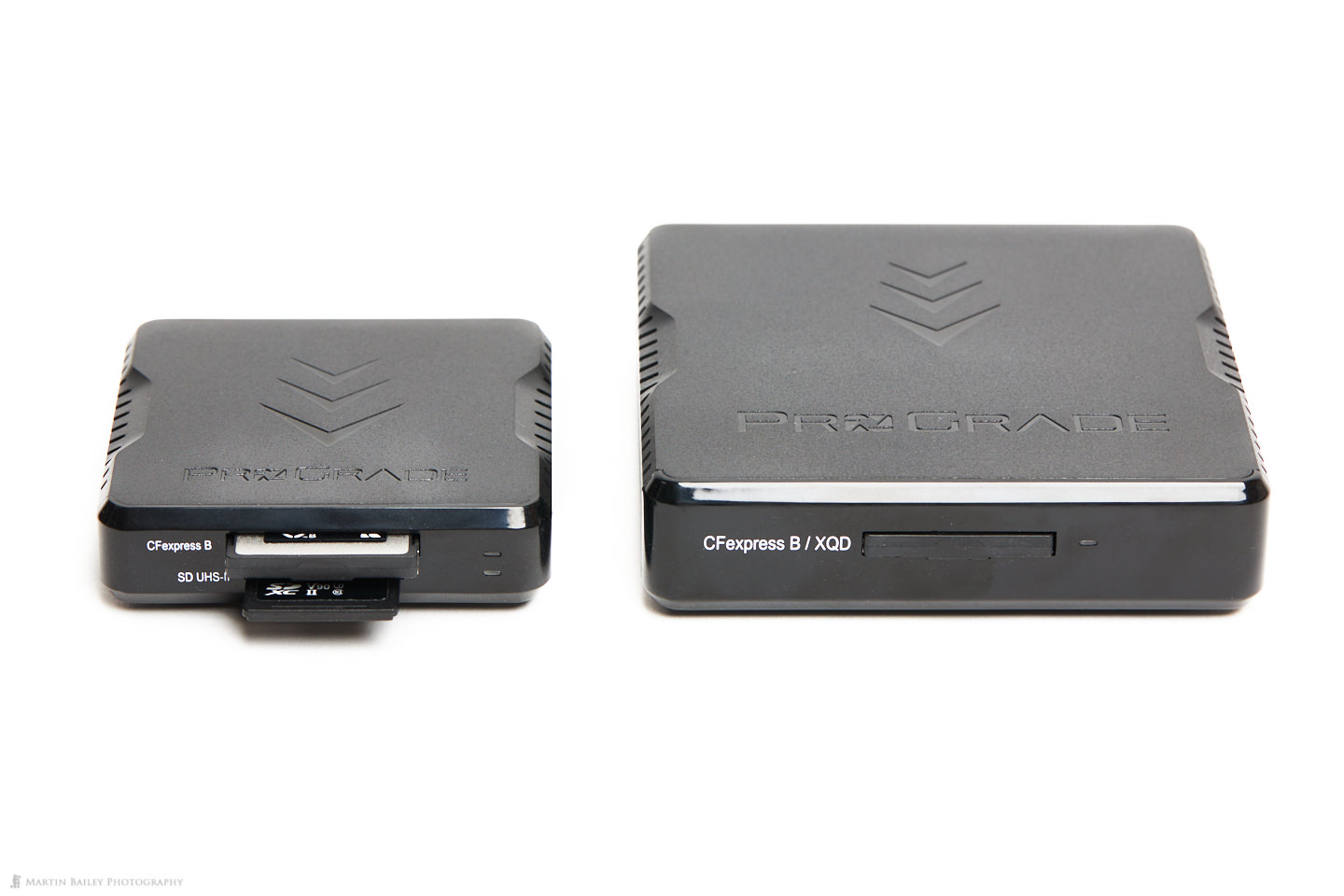
Occasionally people turn up on my workshops and tell me that their image transfer process takes a number of hours, or sometimes the entire evening on heavy wildlife trips. If you are spending this much time transferring images I definitely recommend getting an up to date card reader, and can’t recommend the ProGrade readers highly enough.
My decision to get both readers was based mostly on travel logistics. At my desk, I’m more than happy to use the larger Thunderbolt 3 Single Slot CFexpress card reader, which by the way, with the addition of software drivers also doubles as an XQD card reader, but I don’t have any XQD cards to test so we won’t go into that. This card reader though is around 9.8 x 9.8 cm, which gives it an area of 96 cm2. That is almost double the area of the 7 x 7 cm CFexpress and SD UHS-II dual card reader at 49 cm2.
When packing a little extra is not an issue I may pack the Thunderbolt 3 reader as well, to enable me to import two cards simultaneously, but I think for overseas travel I will probably just leave the larger reader on my desk at home and take just the smaller reader. Anyway, let’s look at some figures so that you can see just how well these cards and the respective readers perform.
Card Comparison
I ran a series of tests using Black Magic Design’s Disk Speed Test application and noted the speeds captured after a couple of cycles had run on both the Write and Read speeds. If you’ve ever used this software you’ll know that there can be a lot of variance between tests, even with the same card in the same card reader, so these aren’t absolute fastest speeds, and they also don’t simulate writing photographs or video to the card. What these figures do is give you an idea of how fast these cards are compared to each other, using the two card readers.
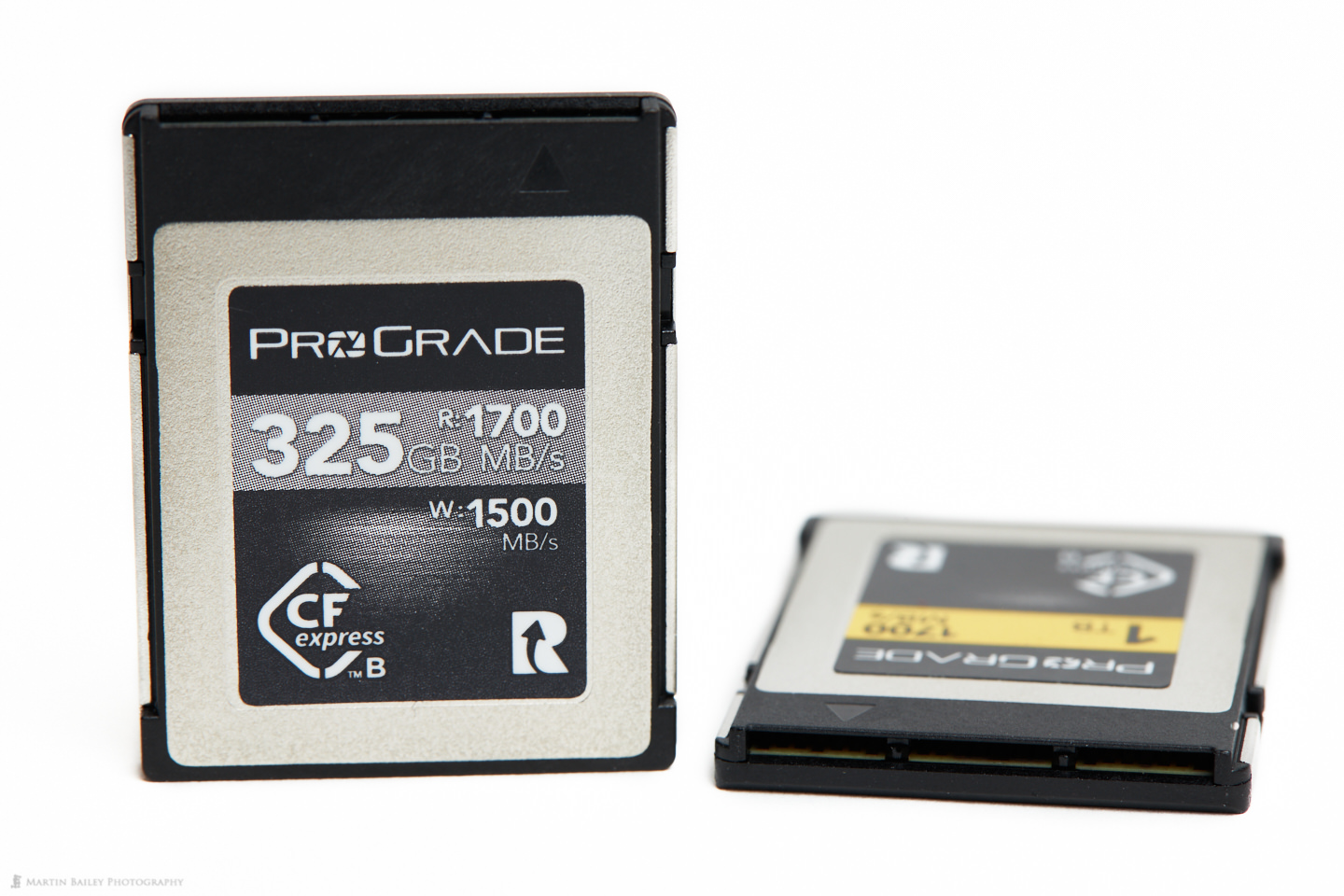
As you can see, the more expensive Cobalt card has much faster write speeds than even ProGrade Digitals own Gold cards, hence the price point. It’s pretty amazing that they have achieved write speeds of around 1300 MB/s and read speeds of coming up to 1450 MB/s. During the tests, there were spikes much higher than these figures as well. The Cobalt card that I tested was a 325GB card, and they also have a 650GB card which I will pick up as soon as the slightly faster-updated version hits the Japan Amazon store.
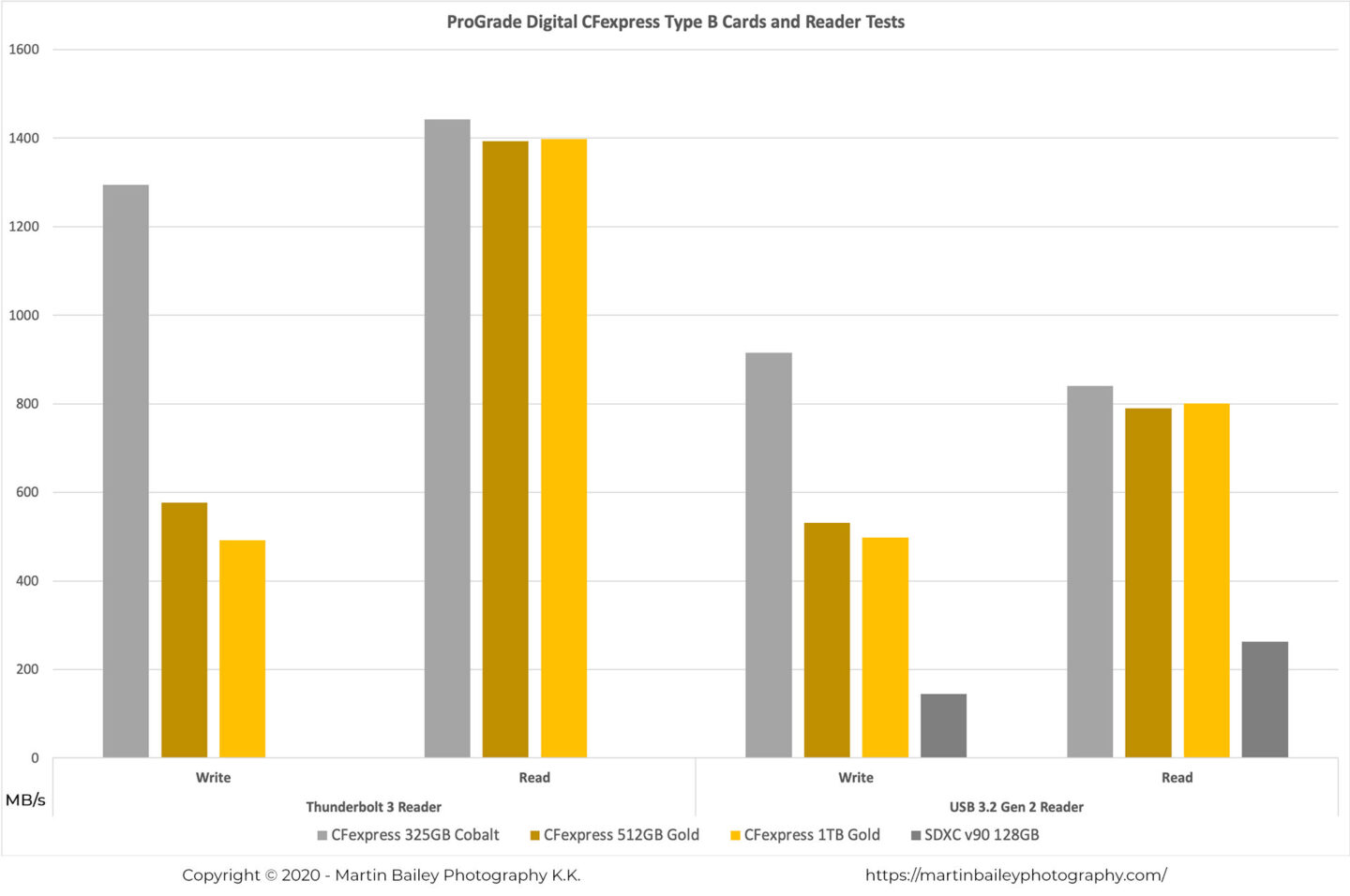
The Gold cards also have very similar read speeds, but just under half the write speeds, at between 500 and 580 MB/s. I also included my fastest SDXC card to put these speeds into context. The cards that I’ve been using for the last few years with my EOS R are also a ProGrade Digital. The main two cards that stayed in both of my cameras was a 128 and a 256 GB Cobalt SDXC v90 card. These are slightly slower than the newest version available, as ProGrade seems to constantly tweak their products to squeeze out as much performance as possible, so seeing a jump in speed on the same card is not uncommon.
Here is a photo of both the CFexpress Type B card and my slightly outdated SDXC card, so that you can see the difference in size. Note that the Type B designation of this particular CFexpress card refers to its size, not the quality or speed. Type B cards are 38.5 x 29.8 x 3.8 mm. There is a smaller Type A card which is 20 x 28 x 2.8 mm and a larger Type C card which measures 54 x 74 x 4.8 mm. The Canon EOR R5 only takes the Type B CFexpress card, and the second slot is for SDXC cards, so be careful when you are buying your new CFexpress card for the R5. There are already some Type A cards in the wild, although Type C are a little more difficult to come by at this point.

In case you want to see the exact numbers that I jotted down for each card, here is a table of my results. As you’d expect, the Thunderbolt 3 card reader is quite a lot faster than the USB 3.2 Gen 2 reader, which keeps all of the cards under its maximum logical transfer speed of 10 Gbps. Keep in mind that the USB standard speeds are quoted in Gbps which is Gigabits per second, but the Disk Speed Test results are spat out in Megabytes per second. If we convert Thunderbolt 3’s 40 Gigabits per second to Gigabyte per second, we’re looking at around 5 Gigabytes per second. Likewise, the 10 Gigabits per second for USB 3.2 Gen 2 becomes 1.25 Gigabytes per second or 1250 Megabytes per second, so it would be physically impossible for the USB 3.2 Gen 2 card reader to transfer data at the speeds we saw with the Thunderbolt 3 reader.
| Reader → | Thunderbolt 3 Reader | USB 3.1 Gen 2 Reader | ||
| Card ↓ | Write | Read | Write | Read |
| CFexpress 325GB Cobalt | 1294.6 | 1442.6 | 915.9 | 840.2 |
| CFexpress 512GB Gold | 576.5 | 1392.8 | 531.8 | 789.3 |
| CFexpress 1TB Gold | 491.3 | 1398.7 | 498.2 | 800.9 |
| SDXC v90 128GB | 145 | 263 | – | – |
And for good measure, I’ll also share the Black Magic Design Disk Speed Test results for the CFexpress cards merged together into a single image.
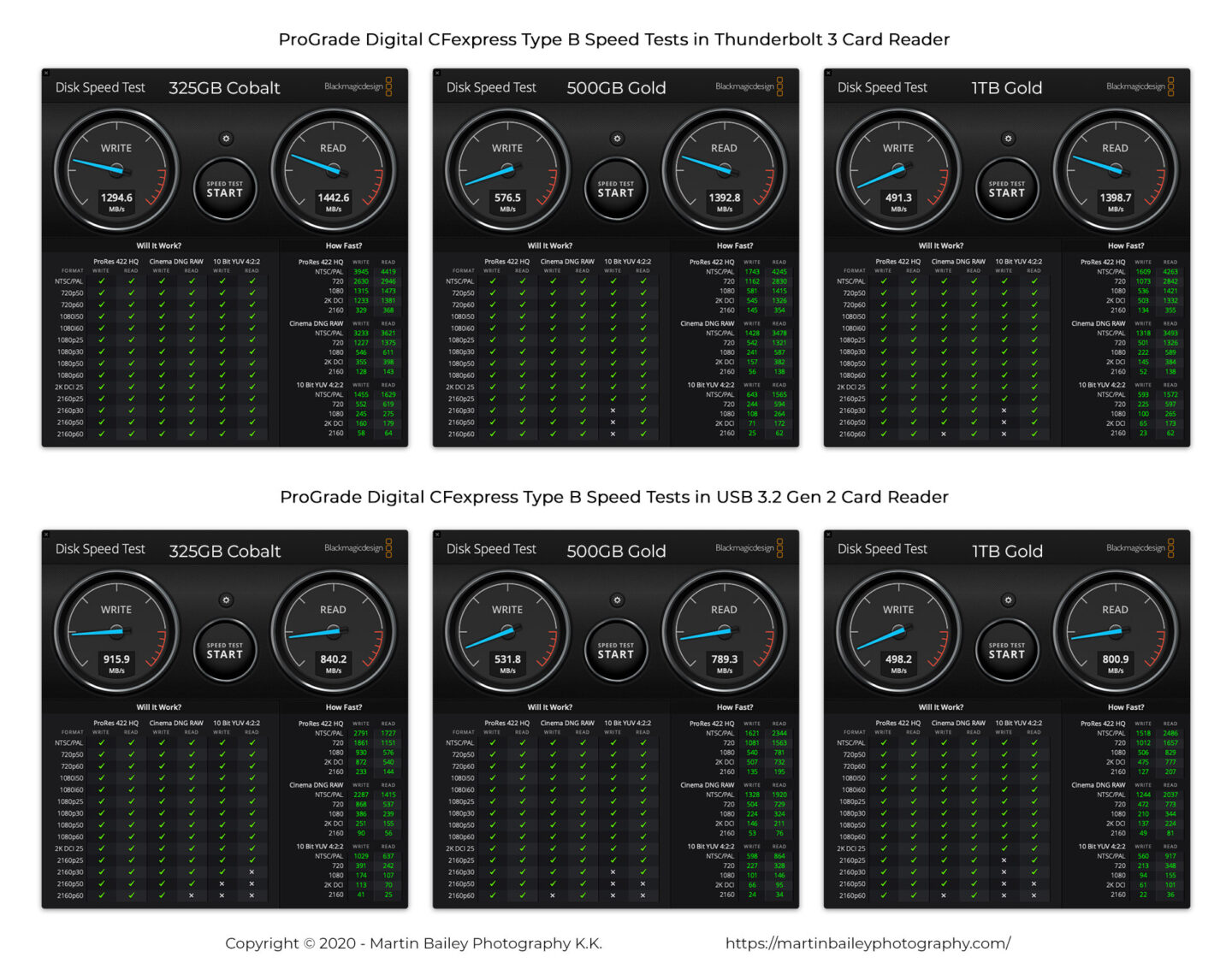
What Does This Mean?
So, to think through what this means in terms of using the EOS R5 with these new CFexpress cards, I checked Canon’s data transfer speeds to see if I could identify any possible areas of concern, so let’s touch on a few of the key points here.
The most demanding format to write in looks to be 8K DCI video in Raw mode which requires a transfer rate of approximately 2600 Mbps, or 325 MB/s, and that is below the minimum write speed that I saw with both the Cobalt and Gold CFexpress cards from ProGrade Digital. Canon also has an area stating that for 8K Raw video you’ll need a CFexpress card with write speeds over 400 MB/s and for ALL-I you’ll need over 200 MB/s. What this tells us is that both the Cobalt and Gold cards from ProGrade Digital should be up to the task of shooting 8K Raw video, but as I haven’t actually tried this yet, I won’t be able to say for sure until I get my R5.
As far as I can see this also poses no issues at all for the high frame rate shooting possible with the R5, but the faster the write speed of the card, the more quickly we should be able to clear our buffer and be ready to continue shooting. Canon are claiming that the Raw buffer size is 66 images on a UHS-I SD card and 88 images on UHS-II SD cards, and they don’t say anything about the buffer size when using CFexpress cards, so my guess is that it’s probably going to be such a high number that filling the buffer will be a very rare occurrence, and probably not something that I want to do using my own camera in my tests, but I will try to do as much as possible and report back as soon as I get my EOS R5.
Unfortunately, I heard from the store that I ordered my R5 from and they are not able to get me mine today, which is the day of release. There is also a statement on the Canon website here in Japan apologizing for not being able to fulfill all orders on the day of release. It would seem that the EOS R5 is already exceeding Canon’s expectations, and I’m disappointed not to be able to get my review underway on the day of release as well. Hopefully, it won’t be many days into August before I get mine, and I’ll report on my findings as soon as I am able to.
As I say, I’ll also update you on how the ProGrade Digital cards fair in the R5, but I am honestly expecting them to work pretty much flawlessly. The only thing that I have on my radar to look out for is the possibility of the camera overheating when shooting 8K video, and this is being put down to the CFexpress cards themselves overheating. I read that when these cards overheat they thermal throttle down to 200 MB/s, which would mean that if you are in a situation where the camera or card does overheat, you would need to switch from 8K Raw video to ALL-I. Personally, I generally shoot in ALL-I anyway, so this is not something that I am really concerned about at this point.
Although I’m looking forward to shooting some 8K video, it’s the still photography specs like the frame-rate and resolution of the R5 that have me salivating over this camera, and the high video specs are really just a bonus. I do see me shooting more video with the R5 than ever before though, simply because the quality will probably be out of this world, but I’ll update you on this in due course as well.
Before we finish I would like to add that I am really excited about these quantum leaps we’re seeing in the technology that are enabling manufacturers to do so much more. I honestly did not expect Canon to come out with a camera the size of the R5 with such high frame-rates at such high resolution, but I also was not aware of the CFexpress standard until I placed my order for the R5 and looked into the type of memory cards it used. I knew as soon as I saw the specs that it could not be SDXC, so was highly interested in this new form factor, and so far have been blown away by all that I’ve seen. Most of this, of course, has been driven by ProGrade Digital, so a hearty thank you goes back to them for the work they do in helping to push the industry and ultimately our creative potential forward.
Support the Podcast and Blog
OK, so we’ll start to wrap this up for now. If you are preparing for the arrival of your Canon EOS R5 and you still need to place an order for a CFexpress memory card, please do consider the ProGrade Digital range. I believe these are the best cards on the market now and can recommend them without any concerns at all. If you want to support my efforts too, please use my affiliate links if you buy from Amazon.com or B&H Photo.
As I mentioned, I did buy one of my new CFexpress cards and the Thunderbolt card reader myself, but the good folks at ProGrade Digital sent me the rest of this gear to test, and although I thank them for that, this does not in any way alter how I report my findings to you. As always with my reviews, I will also let you know if I find any shortcomings with products that I test, regardless of how I obtain the product.
Affiliate Links
Please use these links to support the Podcast and blog! If I don’t have the size that you want to buy listed, click through with these links anyway as I generally still get credit for the purchase that way.
ProGrade Digital 650GB CFexpress Type B Memory Card (Cobalt): https://amzn.to/30zbobA and on B&H https://mbp.ac/cfe650c
ProGrade Digital 325GB CFexpress Type B Memory Card (Cobalt): https://amzn.to/39B4nuQ and on B&H https://mbp.ac/cfe325c
ProGrade Digital 512GB CFexpress Type B Memory Card (Gold): https://amzn.to/2CXBPjh and on B&H https://mbp.ac/cfe512g
ProGrade Digital 1TB CFexpress Type B Memory Card (Gold): https://amzn.to/2CX1vfW and on B&H https://mbp.ac/cfe1tbg
ProGrade Digital Thunderbolt 3 CFexpress Type B card reader: On Amazon https://amzn.to/39ISXVV and on B&H https://mbp.ac/pgdt3r
ProGrade Digital USB 3.2 Gen 2.0 Dual Slot CFexpress and SDXC UHS-II Reader: On B&H https://mbp.ac/pgdcfedsr
And, of course, if you are about to order a Canon EOS R5, please use these links: Canon EOS R5 Body – https://mbp.ac/EOSR5
Canon RF 100-500mm f/4.5-7.1L IS USM Lens – https://mbp.ac/100-500
Canon RF 15-35mm f/2.8L IS USM Lens – https://mbp.ac/15-35
Show Notes
Visit the ProGrade Digital Website here: https://progradedigital.com
Audio
Subscribe in iTunes to get Podcasts delivered automatically to your computer.
Download this Podcast as an MP3 with Chapters.
Visit this page for help on how to view the images in MP3 files.


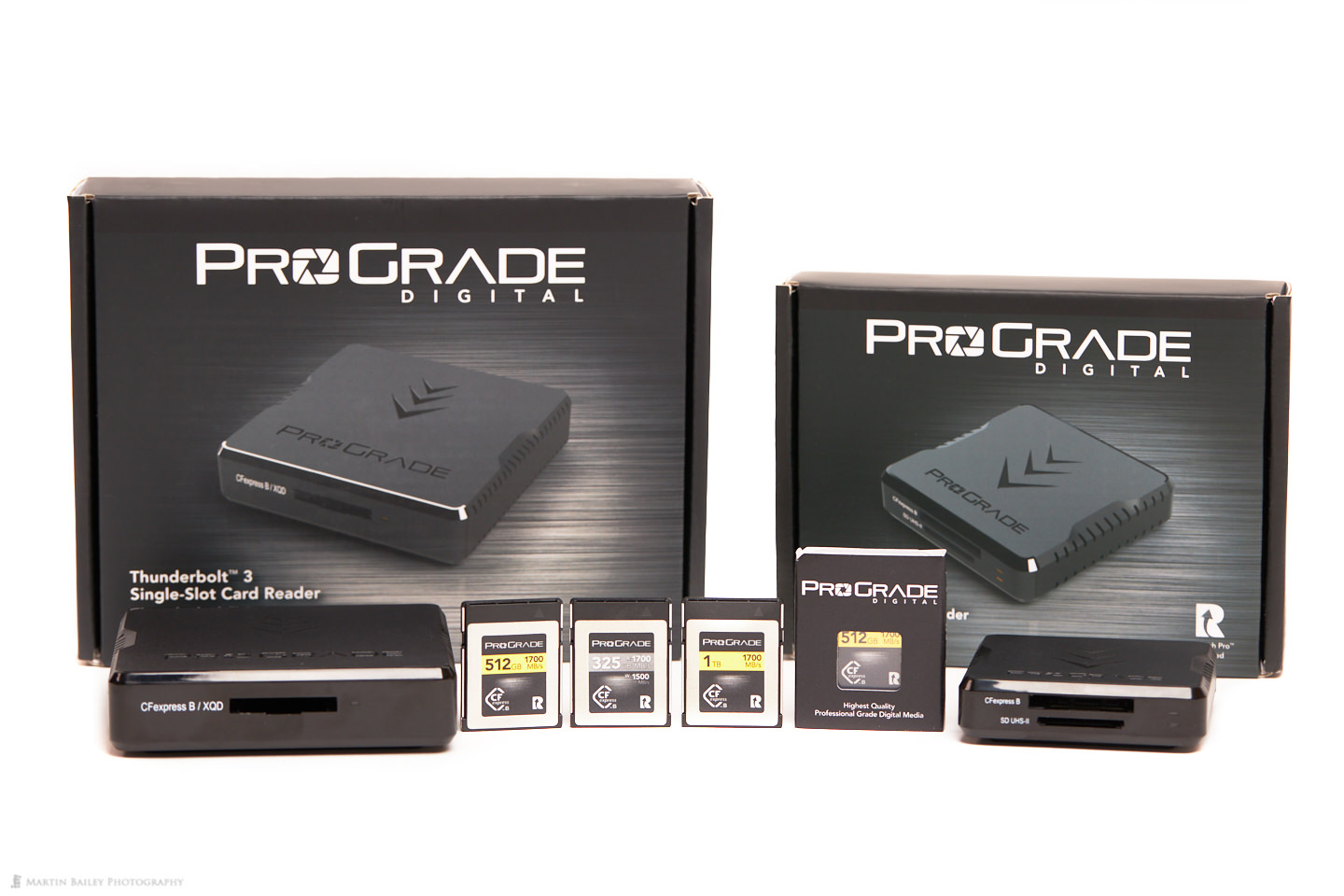

0 Comments